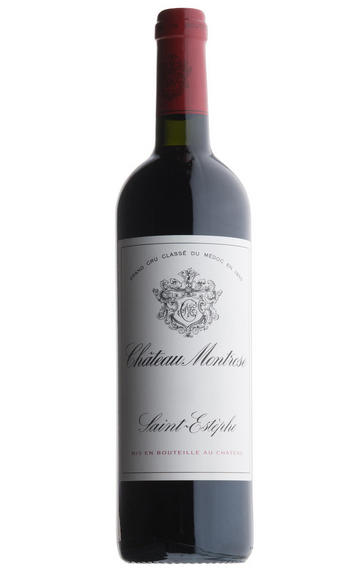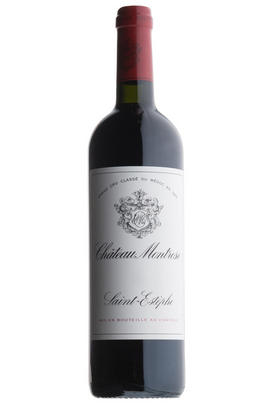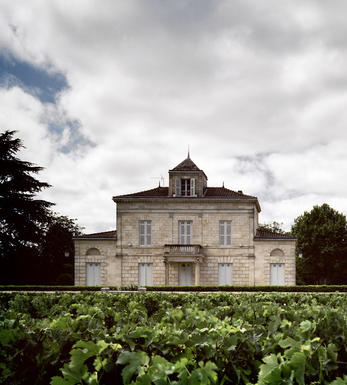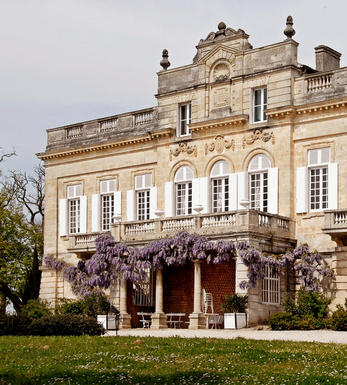
2012 Château Montrose, St Estèphe, Bordeaux

Critics reviews
The 2012 Montrose is one of the bigger, richer wines of the vintage. Super-ripe black cherry, tar, smoke and leather find support in intense tannins that lurk beneath. Today, the tannins are incredibly imposing. The 2012 doesn't have the sheer heft of the epic vintages, but it does have the potential to be one of the real surprises of the year. This is an impressive 2012.
Drink 2024 - 2052
Antonio Galloni, vinous.com (Jan 2016)
Tasted at the chteau, the 2012 Montrose is a blend of 57% Cabernet Sauvignon, 37% Merlot, 5% Cabernet Franc and 1% Petit Verdot picked between 24 September and 20 October. It underwent a particularly long maceration period between 26 and 28 days. It offers more fruit intensity than the 2011 Montrose with blackberry, raspberry and bilberry scents, quite backward and primal yet well defined. The aromatics almost mock you because returning after ten minutes, there are glimpses of underlying dried herb and mineral notes. The palate is medium-bodied, intense and very focused, clearly with more depth and sinew than the 2011, yet displaying impressive precision and energy on the finish, which bodes well for the long-term. Tasted September 2016.
Drink 2020 - 2055
Neal Martin, Wine Advocate (Mar 2017)
Bright deep crimson. Exciting, 'pointed', rather sharply etched impact on the nose. Almost shrill but with great density and definition. Very vibrato! A long-distance runner like Cos d'Estournel.
Drink 2022 - 2040
Jancis Robinson MW, jancisrobinson.com (Apr 2013)
Features lively and pure blackberry, fig and plum fruit, lined with enticing singed mesquite, bramble and tar accents. The muscular, tarry finish shows a twinge of austere chalkiness, but there's ample flesh for balance. Best from 2017 through 2025. 18,333 cases made.
James Molesworth, Wine Spectator (Mar 2015)
James Suckling, jamessuckling.com (Feb 2015)
The inky/purple-colored 2012 offers up scents of white chocolate, creme de cassis, acacia flowers, crushed rocks and forest floor. The tannins are surprisingly soft as the pH is about 3.7, which is slightly higher than the 2010's 3.6. This dense, full-bodied wine is still somewhat monolithic, but it is loaded with concentration and power as well as a long finish. While not totally formed, all the component parts are present. The 2012 will not match the level of the 2009 and 2010, but it should stand out as one of the highlights of 2012.
Only 52% of the production made it into the 2012 Montrose, a blend of 57% Cabernet Sauvignon (harvested between October 13 and 20), 37% Merlot (picked during the third week of September) and a tiny amount of Cabernet Franc and Petit Verdot. The pH was 3.7 and I suspect the alcohol level pushes 14%. It is one of the top successes of the vintage. As new administrator Herve Berland indicated, the severe six-week drought caused the Cabernet skins to become very thick, thus resisting the huge rainfall that fell between October 7 and 9. The late harvest dates suggest very ripe Cabernet Sauvignon, which appears to be exactly what has occurred.
Robert Parker, Wine Advocate (Apr 2013)
From a blend of 37% Merlot, 57% Cabernet Sauvignon, 5% Cabernet Franc and 1% Petit Verdot, Montrose managed to take advantage of the good weather that returned in October, and brought in its last grapes on 20 October. Its gravelly soil also meant it fared far better than the more clay-led St-Estèphe terroirs. Great structure with a wonderful floral aroma and touches of cedar, with good persistency. Astringency on the tannins suggests a good life ahead.
Drink 2022 - 2045
Jane Anson, Decanter.com (Apr 2015)
About this WINE

Château Montrose
Château Montrose is part of our Spotlight on sustainability series. You can view the full range here.
Château Montrose is one of the leading wine properties of St.Estéphe, and produces some of the longest-lived wines in the Médoc. Montrose had been owned by Jean-Louis Charmolue from 1962 until 2006, when it was sold to Martin and Olivier Bouygues, owner of the eponymously named construction firm Bouygues, is located in the east of the appellation, just north of the hamlet of Marbuzet, on a gravel knoll only 800 metres from the Gironde estuary. The proximity of the estuary ensures a microclimate that protects against frost, and the vines, which lie on deep clay-gravel soils, benefit from a south-easterly aspect.
Montrose's wine is typically a blend of 65% Cabernet Sauvignon, 25% Merlot and 10% Cabernet Franc and is matured in oak barriques (30% new) for 18 months.
Montrose wines are traditionally deeply coloured, austere and powerful when young, yet possess superb ageing potential, and when mature are quintessential St.Estèphe clarets. Montrose is classified as a 2ème Cru Classé.

Saint-Estèphe
Saint-Estèphe is the northernmost of the most important communes of the Médoc and borders Pauillac on its southernmost border, with only a gully and stream separates it from Ch. Lafite. To the north lies the Bas-Médoc.
Saint-Estèphe is defined by the depth of its gravel, which is ubiquitous but of varying depths and occasionally very shallow, when clay predominates. This keeps the soil cooler and wetter than its counterparts so that the wines can appear fresh in lighter vintages, but superbly successful in hot, dry years.
The best châteaux in the south of the commune have the deepest soil and the thickest gravel. Cos d'Estournel has an exceptional terroir with its vineyards being located on a south-facing ridge of gravel with excellent drainage.
Saint-Estèphe is the least gravelly of main Médoc communes and in the north of the commune the vineyards are heavier and more clay-based leading to a rustic style of wine being produced.
The wines can appear austere in youth with a discernable ferric note at some châteaux, but the best typically display good depth of colour, pronounced acidity an tannins in youth and are exceptionally long-lived. At their best, they are the equal of almost any Bordeaux. The well-regarded St Estèphe co-operative controls the production of about half the appellation.
Recommended Châteaux
Cos (Ch. Cos d'Estournel), Ch. Montrose, Ch. Calon-Ségur, Ch. Lafon-Rochet, Ch. Les Ormes de Pez, Ch. Beau-Site, Ch. Cos Labory, Ch. Phélan-Ségur

Cabernet Sauvignon Blend
Cabernet Sauvignon lends itself particularly well in blends with Merlot. This is actually the archetypal Bordeaux blend, though in different proportions in the sub-regions and sometimes topped up with Cabernet Franc, Malbec, and Petit Verdot.
In the Médoc and Graves the percentage of Cabernet Sauvignon in the blend can range from 95% (Mouton-Rothschild) to as low as 40%. It is particularly suited to the dry, warm, free- draining, gravel-rich soils and is responsible for the redolent cassis characteristics as well as the depth of colour, tannic structure and pronounced acidity of Médoc wines. However 100% Cabernet Sauvignon wines can be slightly hollow-tasting in the middle palate and Merlot with its generous, fleshy fruit flavours acts as a perfect foil by filling in this cavity.
In St-Emilion and Pomerol, the blends are Merlot dominated as Cabernet Sauvignon can struggle to ripen there - when it is included, it adds structure and body to the wine. Sassicaia is the most famous Bordeaux blend in Italy and has spawned many imitations, whereby the blend is now firmly established in the New World and particularly in California and Australia.


Buying options
Add to wishlist
Description
Ch. Montrose is at the leading edge of low-impact winemaking in Bordeaux. For more than 15 years, the property has been improving biodiversity and vineyard health energy use – plus, all the CO2 from fermentation is captured and turned into bicarbonate of soda. “Ch. Montrose is in the middle of nature,” says spokesperson Lorraine Watrin. “Our vision here is to reveal the beautiful riches of the terroir.”
In 2010, Ch. Montrose purchased 22ha of prime land from their neighbours, Ch. Phélan-Ségur. The vineyard borders Montrose on its western side and is planted with 2/3 Merlot and 1/3 Cabernet Sauvignon. According to who you speak with, this may be Phélan’s best parcel, and the Merlot is especially prized. This has given the Montrose team a short-term puzzle, resulting in a higher-than-usual proportion of Merlot in the blend for the Grand Vin. This will be adjusted over the coming years as existing Montrose Merlot on excellent Cabernet land near the river is replanted to the latter. Still, there is an embarrassment of fine Merlot on the estate. Not that this is a problem: in 2012, Merlot excelled.
This wine, with 57% Cabernet Sauvignon, 37% Merlot, 5% Cabernet Franc and 1% Petit Verdot, is dense and spicy, with the very low-yielding Cabernet fully ripe and giving an earnest backbone to some high-quality Merlot. This is perhaps not a traditional Montrose, but it is undoubtedly a beguiling one.
Mark Pardoe MW, Wine Buying Director, Berry Bros. & Rudd
wine at a glance
Delivery and quality guarantee